MGT501 Business Environment: Analyzing Uber's External Factors
VerifiedAdded on 2023/06/03
|10
|2239
|213
Report
AI Summary
This report provides an analysis of Uber's business environment, focusing on the external factors that impact the company. It utilizes the PESTLE framework to examine political, economic, socio-cultural, technological, legal, and environmental influences. The report identifies challenges Uber faces, such as regulatory hurdles, legal lawsuits, and the need for sustainable practices. Recommendations include adopting a GLOCAL strategy to better understand local markets and treating drivers as employees rather than contractors. The analysis emphasizes the importance of adapting to changing times and leveraging technology effectively. Desklib offers a platform for students to access similar solved assignments and past papers for comprehensive study resources.
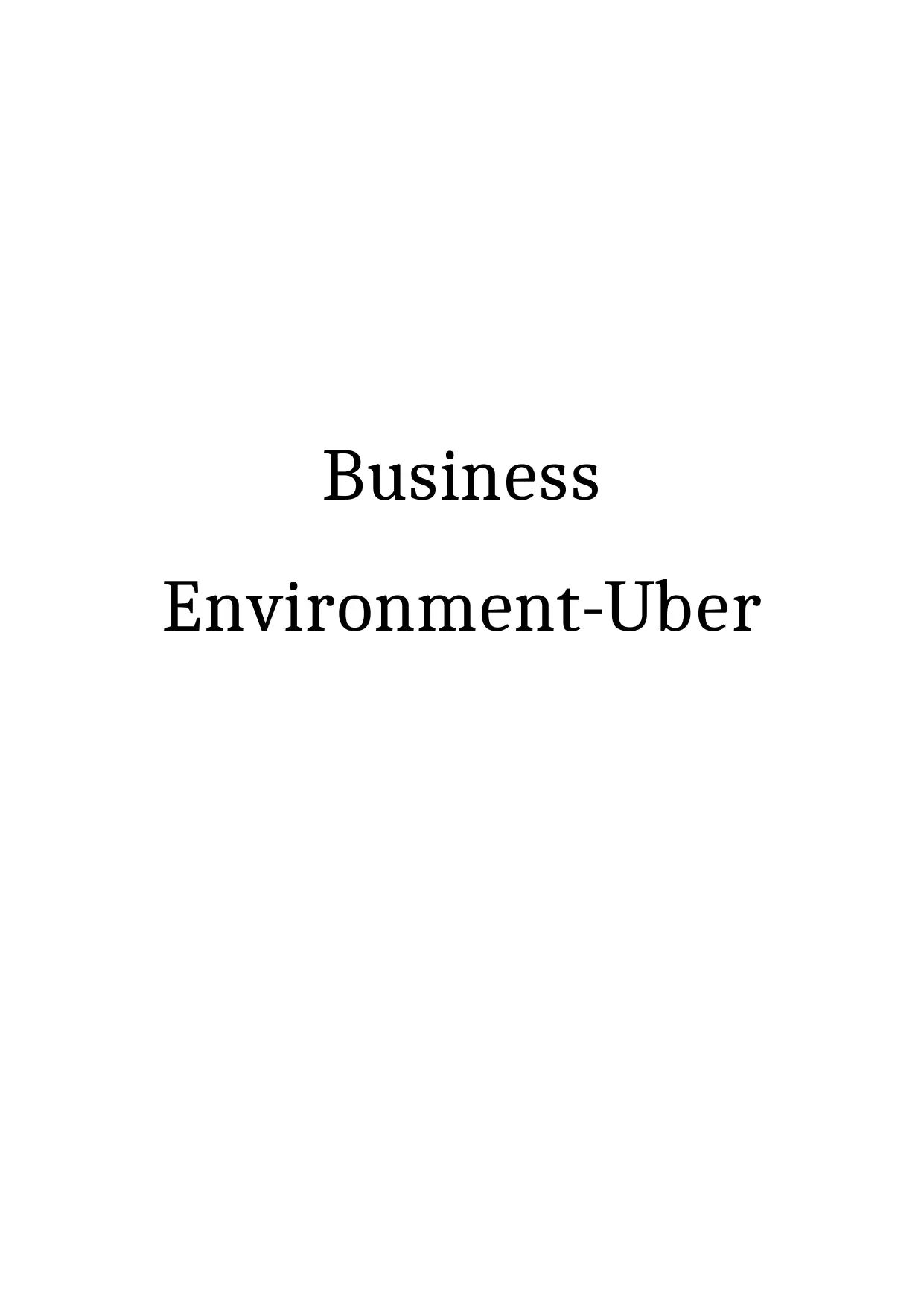
Business
Environment-Uber
Environment-Uber
Paraphrase This Document
Need a fresh take? Get an instant paraphrase of this document with our AI Paraphraser
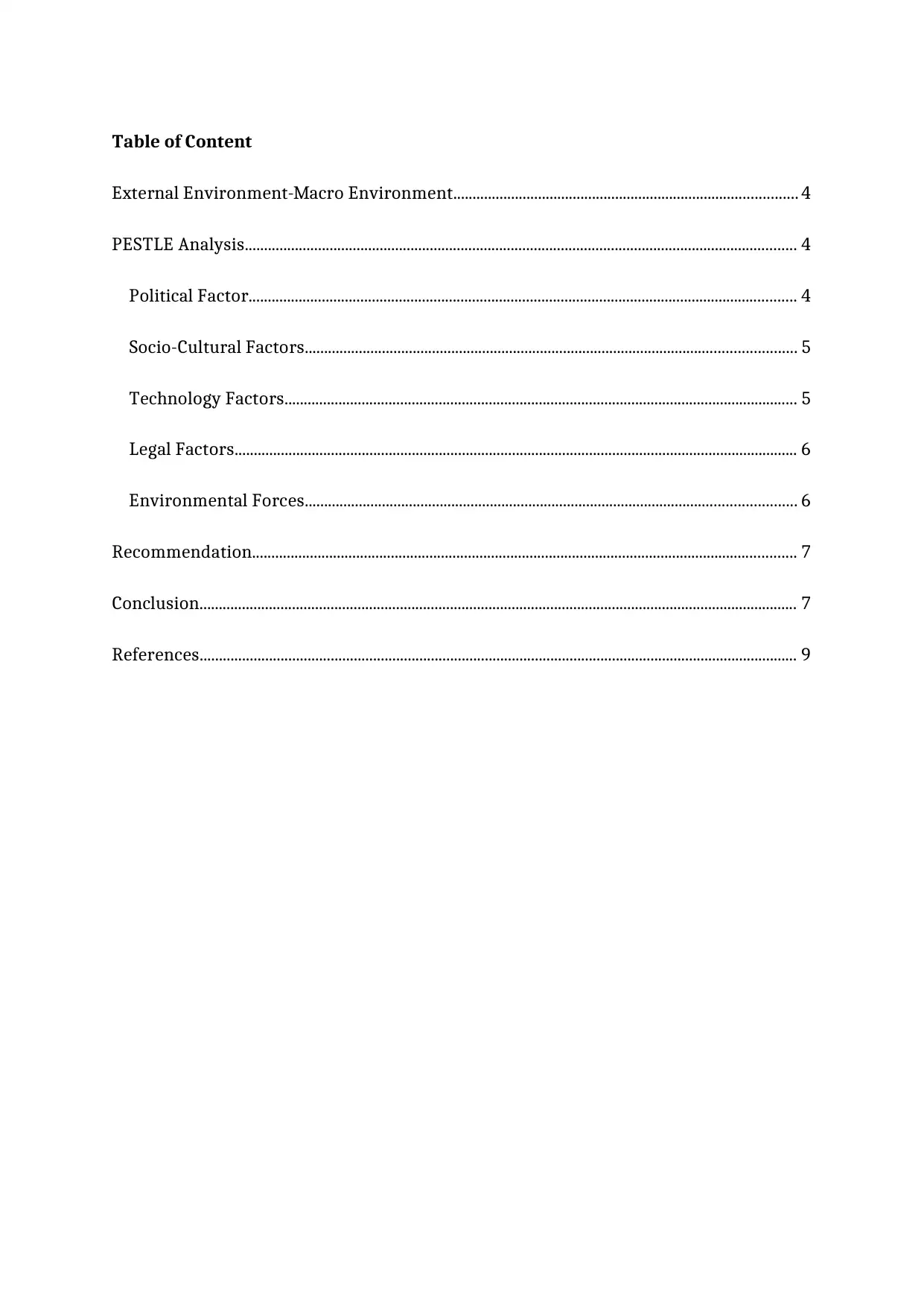
Table of Content
External Environment-Macro Environment......................................................................................... 4
PESTLE Analysis............................................................................................................................................... 4
Political Factor.............................................................................................................................................. 4
Socio-Cultural Factors............................................................................................................................... 5
Technology Factors..................................................................................................................................... 5
Legal Factors.................................................................................................................................................. 6
Environmental Forces............................................................................................................................... 6
Recommendation............................................................................................................................................. 7
Conclusion........................................................................................................................................................... 7
References........................................................................................................................................................... 9
External Environment-Macro Environment......................................................................................... 4
PESTLE Analysis............................................................................................................................................... 4
Political Factor.............................................................................................................................................. 4
Socio-Cultural Factors............................................................................................................................... 5
Technology Factors..................................................................................................................................... 5
Legal Factors.................................................................................................................................................. 6
Environmental Forces............................................................................................................................... 6
Recommendation............................................................................................................................................. 7
Conclusion........................................................................................................................................................... 7
References........................................................................................................................................................... 9
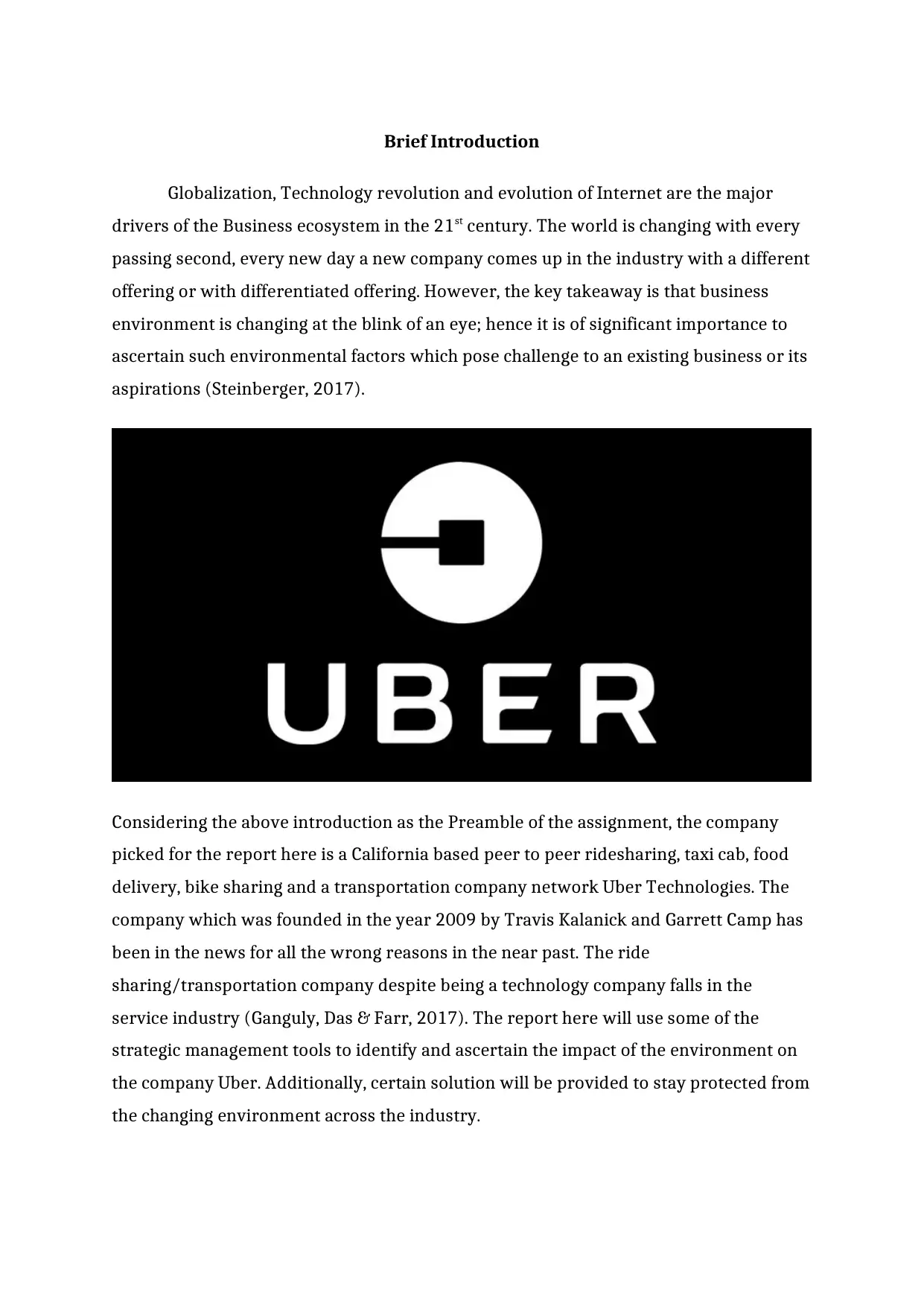
Brief Introduction
Globalization, Technology revolution and evolution of Internet are the major
drivers of the Business ecosystem in the 21st century. The world is changing with every
passing second, every new day a new company comes up in the industry with a different
offering or with differentiated offering. However, the key takeaway is that business
environment is changing at the blink of an eye; hence it is of significant importance to
ascertain such environmental factors which pose challenge to an existing business or its
aspirations (Steinberger, 2017).
Considering the above introduction as the Preamble of the assignment, the company
picked for the report here is a California based peer to peer ridesharing, taxi cab, food
delivery, bike sharing and a transportation company network Uber Technologies. The
company which was founded in the year 2009 by Travis Kalanick and Garrett Camp has
been in the news for all the wrong reasons in the near past. The ride
sharing/transportation company despite being a technology company falls in the
service industry (Ganguly, Das & Farr, 2017). The report here will use some of the
strategic management tools to identify and ascertain the impact of the environment on
the company Uber. Additionally, certain solution will be provided to stay protected from
the changing environment across the industry.
Globalization, Technology revolution and evolution of Internet are the major
drivers of the Business ecosystem in the 21st century. The world is changing with every
passing second, every new day a new company comes up in the industry with a different
offering or with differentiated offering. However, the key takeaway is that business
environment is changing at the blink of an eye; hence it is of significant importance to
ascertain such environmental factors which pose challenge to an existing business or its
aspirations (Steinberger, 2017).
Considering the above introduction as the Preamble of the assignment, the company
picked for the report here is a California based peer to peer ridesharing, taxi cab, food
delivery, bike sharing and a transportation company network Uber Technologies. The
company which was founded in the year 2009 by Travis Kalanick and Garrett Camp has
been in the news for all the wrong reasons in the near past. The ride
sharing/transportation company despite being a technology company falls in the
service industry (Ganguly, Das & Farr, 2017). The report here will use some of the
strategic management tools to identify and ascertain the impact of the environment on
the company Uber. Additionally, certain solution will be provided to stay protected from
the changing environment across the industry.
⊘ This is a preview!⊘
Do you want full access?
Subscribe today to unlock all pages.

Trusted by 1+ million students worldwide
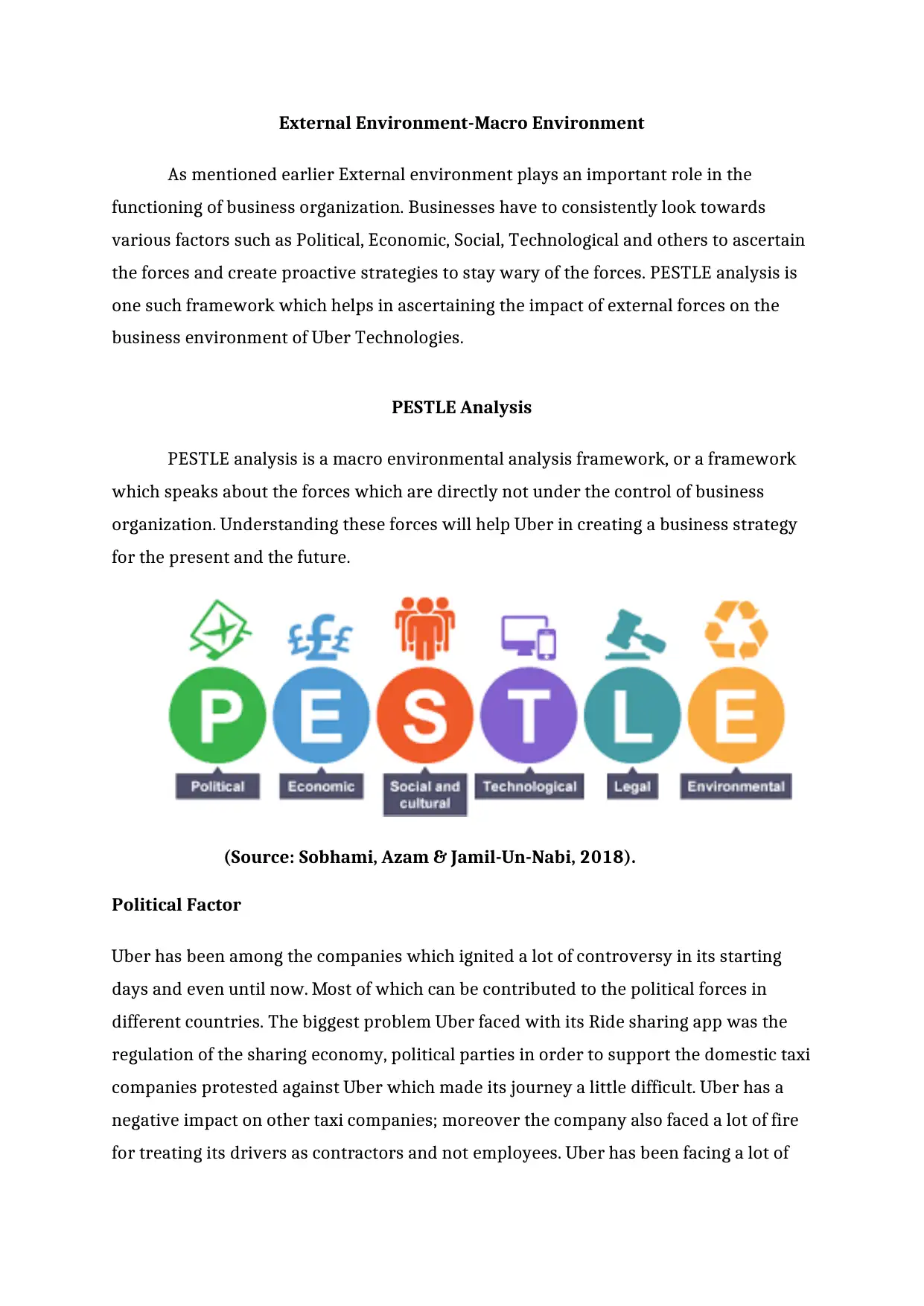
External Environment-Macro Environment
As mentioned earlier External environment plays an important role in the
functioning of business organization. Businesses have to consistently look towards
various factors such as Political, Economic, Social, Technological and others to ascertain
the forces and create proactive strategies to stay wary of the forces. PESTLE analysis is
one such framework which helps in ascertaining the impact of external forces on the
business environment of Uber Technologies.
PESTLE Analysis
PESTLE analysis is a macro environmental analysis framework, or a framework
which speaks about the forces which are directly not under the control of business
organization. Understanding these forces will help Uber in creating a business strategy
for the present and the future.
(Source: Sobhami, Azam & Jamil-Un-Nabi, 2018).
Political Factor
Uber has been among the companies which ignited a lot of controversy in its starting
days and even until now. Most of which can be contributed to the political forces in
different countries. The biggest problem Uber faced with its Ride sharing app was the
regulation of the sharing economy, political parties in order to support the domestic taxi
companies protested against Uber which made its journey a little difficult. Uber has a
negative impact on other taxi companies; moreover the company also faced a lot of fire
for treating its drivers as contractors and not employees. Uber has been facing a lot of
As mentioned earlier External environment plays an important role in the
functioning of business organization. Businesses have to consistently look towards
various factors such as Political, Economic, Social, Technological and others to ascertain
the forces and create proactive strategies to stay wary of the forces. PESTLE analysis is
one such framework which helps in ascertaining the impact of external forces on the
business environment of Uber Technologies.
PESTLE Analysis
PESTLE analysis is a macro environmental analysis framework, or a framework
which speaks about the forces which are directly not under the control of business
organization. Understanding these forces will help Uber in creating a business strategy
for the present and the future.
(Source: Sobhami, Azam & Jamil-Un-Nabi, 2018).
Political Factor
Uber has been among the companies which ignited a lot of controversy in its starting
days and even until now. Most of which can be contributed to the political forces in
different countries. The biggest problem Uber faced with its Ride sharing app was the
regulation of the sharing economy, political parties in order to support the domestic taxi
companies protested against Uber which made its journey a little difficult. Uber has a
negative impact on other taxi companies; moreover the company also faced a lot of fire
for treating its drivers as contractors and not employees. Uber has been facing a lot of
Paraphrase This Document
Need a fresh take? Get an instant paraphrase of this document with our AI Paraphraser
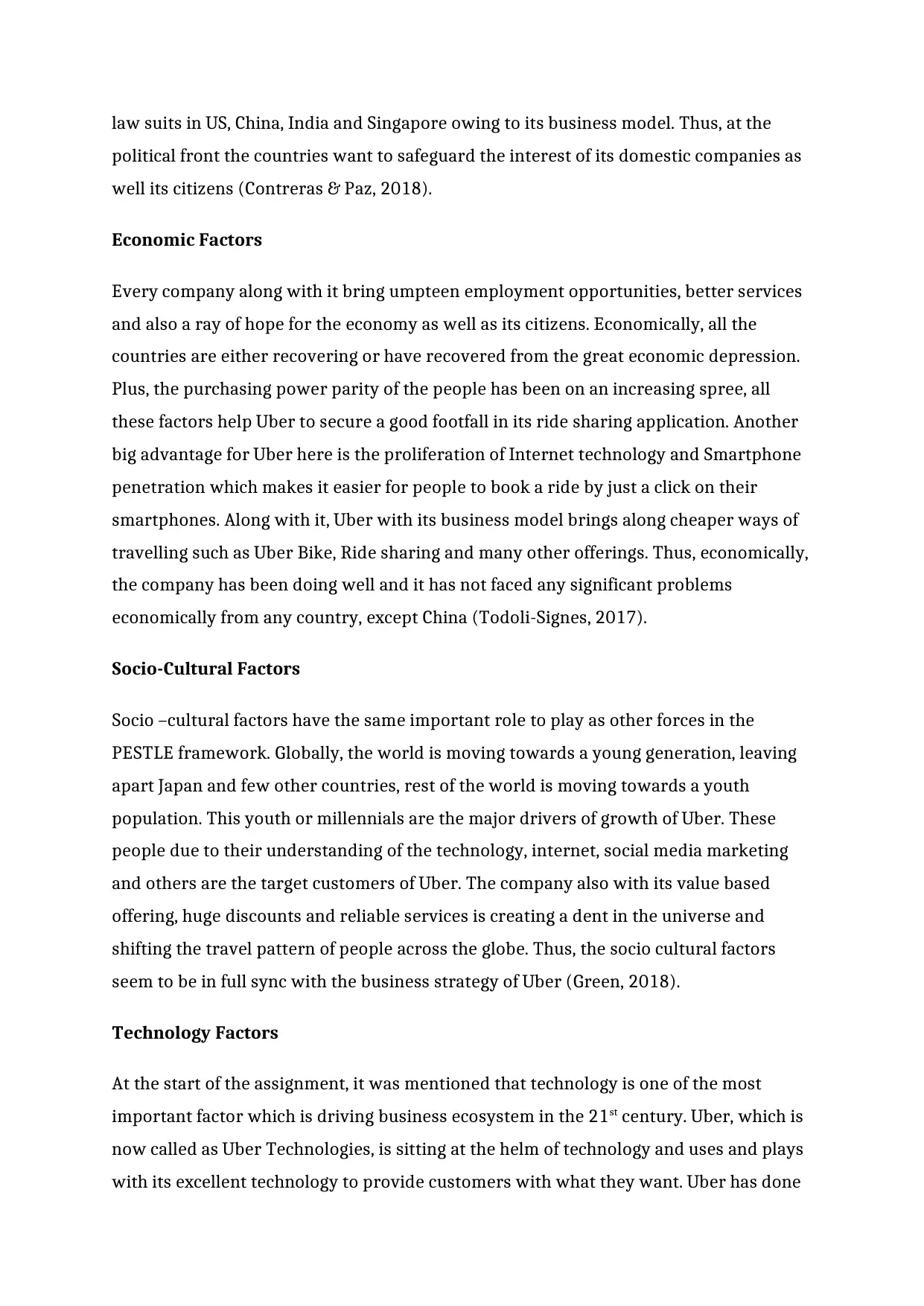
law suits in US, China, India and Singapore owing to its business model. Thus, at the
political front the countries want to safeguard the interest of its domestic companies as
well its citizens (Contreras & Paz, 2018).
Economic Factors
Every company along with it bring umpteen employment opportunities, better services
and also a ray of hope for the economy as well as its citizens. Economically, all the
countries are either recovering or have recovered from the great economic depression.
Plus, the purchasing power parity of the people has been on an increasing spree, all
these factors help Uber to secure a good footfall in its ride sharing application. Another
big advantage for Uber here is the proliferation of Internet technology and Smartphone
penetration which makes it easier for people to book a ride by just a click on their
smartphones. Along with it, Uber with its business model brings along cheaper ways of
travelling such as Uber Bike, Ride sharing and many other offerings. Thus, economically,
the company has been doing well and it has not faced any significant problems
economically from any country, except China (Todoli-Signes, 2017).
Socio-Cultural Factors
Socio –cultural factors have the same important role to play as other forces in the
PESTLE framework. Globally, the world is moving towards a young generation, leaving
apart Japan and few other countries, rest of the world is moving towards a youth
population. This youth or millennials are the major drivers of growth of Uber. These
people due to their understanding of the technology, internet, social media marketing
and others are the target customers of Uber. The company also with its value based
offering, huge discounts and reliable services is creating a dent in the universe and
shifting the travel pattern of people across the globe. Thus, the socio cultural factors
seem to be in full sync with the business strategy of Uber (Green, 2018).
Technology Factors
At the start of the assignment, it was mentioned that technology is one of the most
important factor which is driving business ecosystem in the 21st century. Uber, which is
now called as Uber Technologies, is sitting at the helm of technology and uses and plays
with its excellent technology to provide customers with what they want. Uber has done
political front the countries want to safeguard the interest of its domestic companies as
well its citizens (Contreras & Paz, 2018).
Economic Factors
Every company along with it bring umpteen employment opportunities, better services
and also a ray of hope for the economy as well as its citizens. Economically, all the
countries are either recovering or have recovered from the great economic depression.
Plus, the purchasing power parity of the people has been on an increasing spree, all
these factors help Uber to secure a good footfall in its ride sharing application. Another
big advantage for Uber here is the proliferation of Internet technology and Smartphone
penetration which makes it easier for people to book a ride by just a click on their
smartphones. Along with it, Uber with its business model brings along cheaper ways of
travelling such as Uber Bike, Ride sharing and many other offerings. Thus, economically,
the company has been doing well and it has not faced any significant problems
economically from any country, except China (Todoli-Signes, 2017).
Socio-Cultural Factors
Socio –cultural factors have the same important role to play as other forces in the
PESTLE framework. Globally, the world is moving towards a young generation, leaving
apart Japan and few other countries, rest of the world is moving towards a youth
population. This youth or millennials are the major drivers of growth of Uber. These
people due to their understanding of the technology, internet, social media marketing
and others are the target customers of Uber. The company also with its value based
offering, huge discounts and reliable services is creating a dent in the universe and
shifting the travel pattern of people across the globe. Thus, the socio cultural factors
seem to be in full sync with the business strategy of Uber (Green, 2018).
Technology Factors
At the start of the assignment, it was mentioned that technology is one of the most
important factor which is driving business ecosystem in the 21st century. Uber, which is
now called as Uber Technologies, is sitting at the helm of technology and uses and plays
with its excellent technology to provide customers with what they want. Uber has done
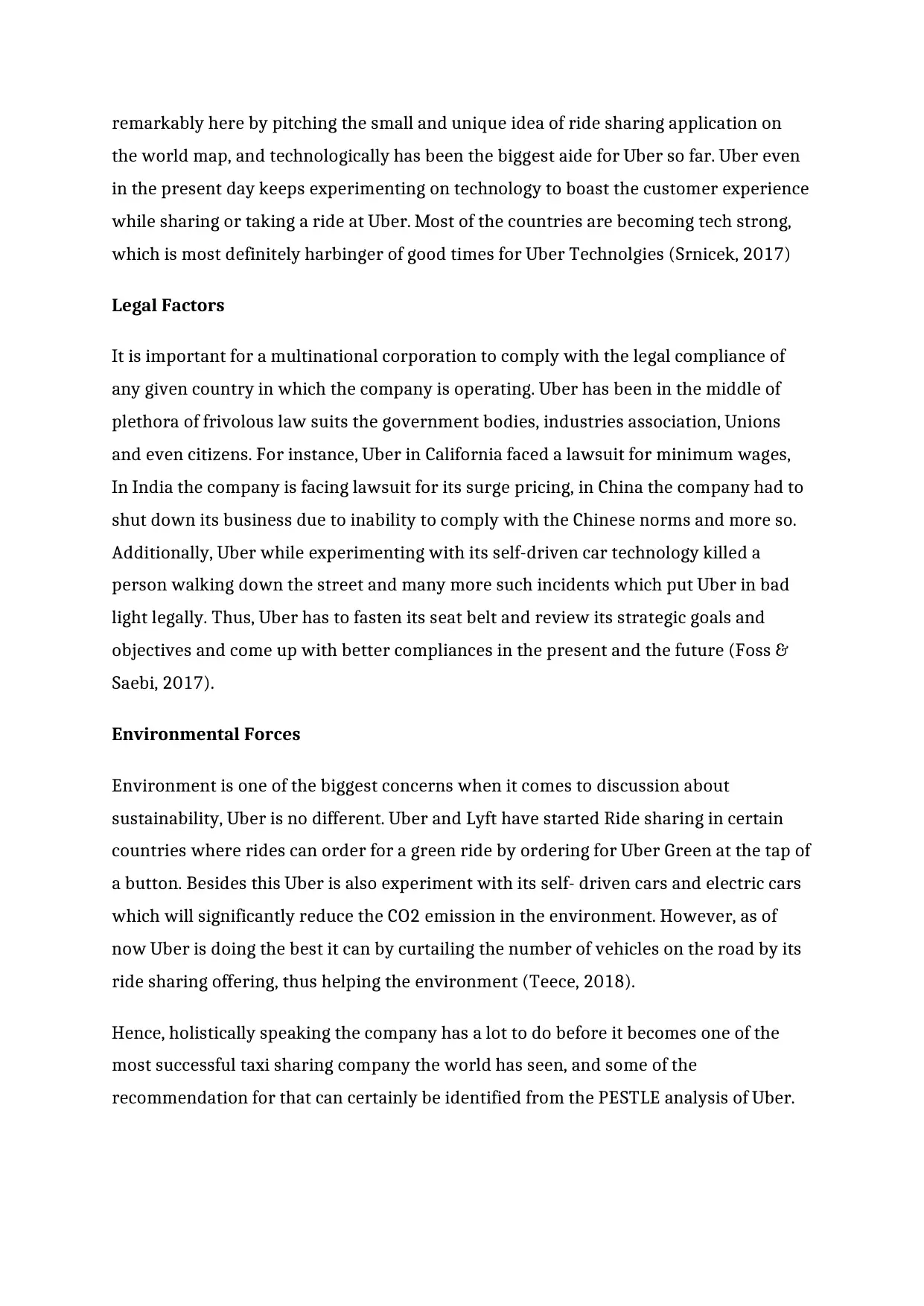
remarkably here by pitching the small and unique idea of ride sharing application on
the world map, and technologically has been the biggest aide for Uber so far. Uber even
in the present day keeps experimenting on technology to boast the customer experience
while sharing or taking a ride at Uber. Most of the countries are becoming tech strong,
which is most definitely harbinger of good times for Uber Technolgies (Srnicek, 2017)
Legal Factors
It is important for a multinational corporation to comply with the legal compliance of
any given country in which the company is operating. Uber has been in the middle of
plethora of frivolous law suits the government bodies, industries association, Unions
and even citizens. For instance, Uber in California faced a lawsuit for minimum wages,
In India the company is facing lawsuit for its surge pricing, in China the company had to
shut down its business due to inability to comply with the Chinese norms and more so.
Additionally, Uber while experimenting with its self-driven car technology killed a
person walking down the street and many more such incidents which put Uber in bad
light legally. Thus, Uber has to fasten its seat belt and review its strategic goals and
objectives and come up with better compliances in the present and the future (Foss &
Saebi, 2017).
Environmental Forces
Environment is one of the biggest concerns when it comes to discussion about
sustainability, Uber is no different. Uber and Lyft have started Ride sharing in certain
countries where rides can order for a green ride by ordering for Uber Green at the tap of
a button. Besides this Uber is also experiment with its self- driven cars and electric cars
which will significantly reduce the CO2 emission in the environment. However, as of
now Uber is doing the best it can by curtailing the number of vehicles on the road by its
ride sharing offering, thus helping the environment (Teece, 2018).
Hence, holistically speaking the company has a lot to do before it becomes one of the
most successful taxi sharing company the world has seen, and some of the
recommendation for that can certainly be identified from the PESTLE analysis of Uber.
the world map, and technologically has been the biggest aide for Uber so far. Uber even
in the present day keeps experimenting on technology to boast the customer experience
while sharing or taking a ride at Uber. Most of the countries are becoming tech strong,
which is most definitely harbinger of good times for Uber Technolgies (Srnicek, 2017)
Legal Factors
It is important for a multinational corporation to comply with the legal compliance of
any given country in which the company is operating. Uber has been in the middle of
plethora of frivolous law suits the government bodies, industries association, Unions
and even citizens. For instance, Uber in California faced a lawsuit for minimum wages,
In India the company is facing lawsuit for its surge pricing, in China the company had to
shut down its business due to inability to comply with the Chinese norms and more so.
Additionally, Uber while experimenting with its self-driven car technology killed a
person walking down the street and many more such incidents which put Uber in bad
light legally. Thus, Uber has to fasten its seat belt and review its strategic goals and
objectives and come up with better compliances in the present and the future (Foss &
Saebi, 2017).
Environmental Forces
Environment is one of the biggest concerns when it comes to discussion about
sustainability, Uber is no different. Uber and Lyft have started Ride sharing in certain
countries where rides can order for a green ride by ordering for Uber Green at the tap of
a button. Besides this Uber is also experiment with its self- driven cars and electric cars
which will significantly reduce the CO2 emission in the environment. However, as of
now Uber is doing the best it can by curtailing the number of vehicles on the road by its
ride sharing offering, thus helping the environment (Teece, 2018).
Hence, holistically speaking the company has a lot to do before it becomes one of the
most successful taxi sharing company the world has seen, and some of the
recommendation for that can certainly be identified from the PESTLE analysis of Uber.
⊘ This is a preview!⊘
Do you want full access?
Subscribe today to unlock all pages.

Trusted by 1+ million students worldwide
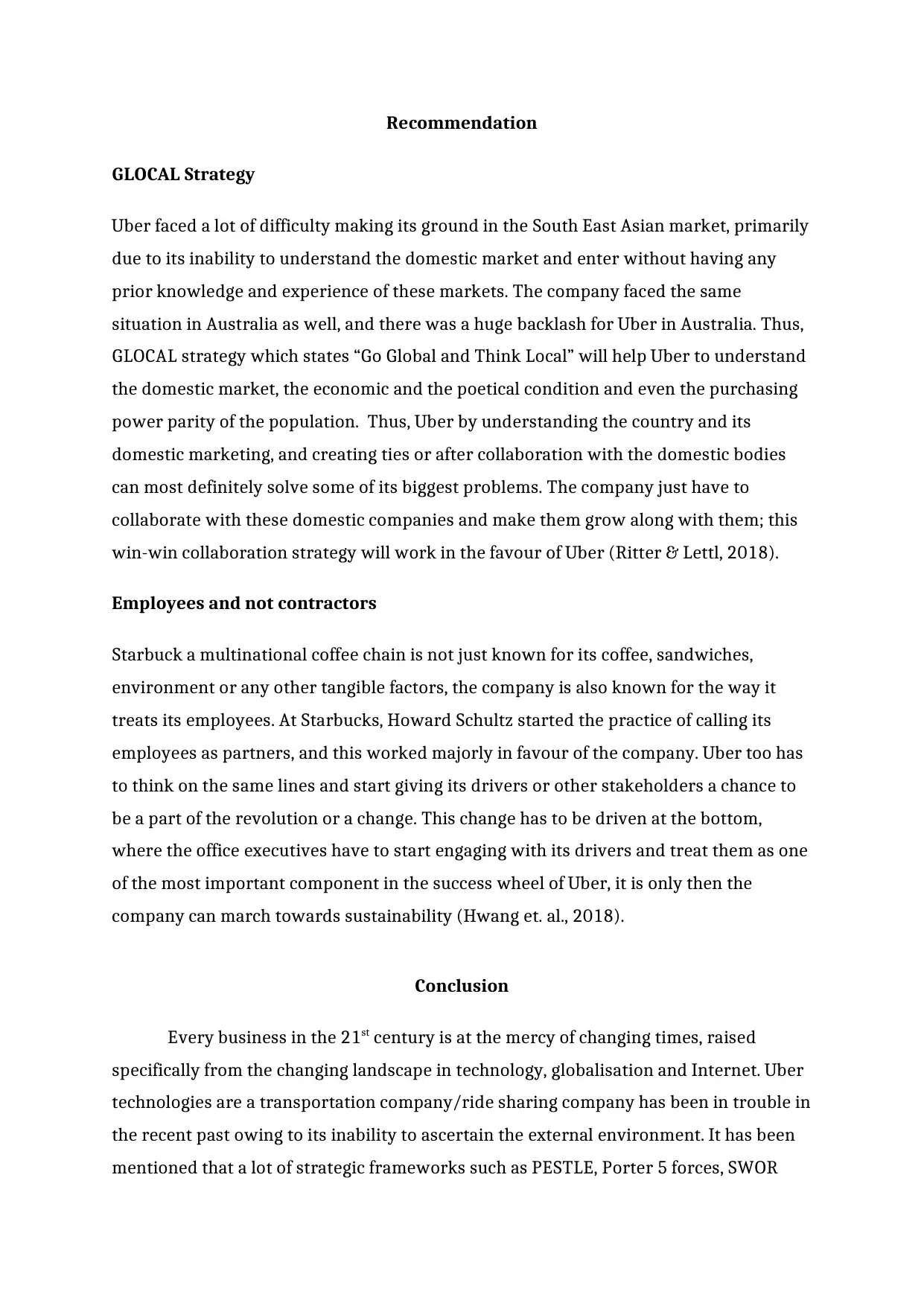
Recommendation
GLOCAL Strategy
Uber faced a lot of difficulty making its ground in the South East Asian market, primarily
due to its inability to understand the domestic market and enter without having any
prior knowledge and experience of these markets. The company faced the same
situation in Australia as well, and there was a huge backlash for Uber in Australia. Thus,
GLOCAL strategy which states “Go Global and Think Local” will help Uber to understand
the domestic market, the economic and the poetical condition and even the purchasing
power parity of the population. Thus, Uber by understanding the country and its
domestic marketing, and creating ties or after collaboration with the domestic bodies
can most definitely solve some of its biggest problems. The company just have to
collaborate with these domestic companies and make them grow along with them; this
win-win collaboration strategy will work in the favour of Uber (Ritter & Lettl, 2018).
Employees and not contractors
Starbuck a multinational coffee chain is not just known for its coffee, sandwiches,
environment or any other tangible factors, the company is also known for the way it
treats its employees. At Starbucks, Howard Schultz started the practice of calling its
employees as partners, and this worked majorly in favour of the company. Uber too has
to think on the same lines and start giving its drivers or other stakeholders a chance to
be a part of the revolution or a change. This change has to be driven at the bottom,
where the office executives have to start engaging with its drivers and treat them as one
of the most important component in the success wheel of Uber, it is only then the
company can march towards sustainability (Hwang et. al., 2018).
Conclusion
Every business in the 21st century is at the mercy of changing times, raised
specifically from the changing landscape in technology, globalisation and Internet. Uber
technologies are a transportation company/ride sharing company has been in trouble in
the recent past owing to its inability to ascertain the external environment. It has been
mentioned that a lot of strategic frameworks such as PESTLE, Porter 5 forces, SWOR
GLOCAL Strategy
Uber faced a lot of difficulty making its ground in the South East Asian market, primarily
due to its inability to understand the domestic market and enter without having any
prior knowledge and experience of these markets. The company faced the same
situation in Australia as well, and there was a huge backlash for Uber in Australia. Thus,
GLOCAL strategy which states “Go Global and Think Local” will help Uber to understand
the domestic market, the economic and the poetical condition and even the purchasing
power parity of the population. Thus, Uber by understanding the country and its
domestic marketing, and creating ties or after collaboration with the domestic bodies
can most definitely solve some of its biggest problems. The company just have to
collaborate with these domestic companies and make them grow along with them; this
win-win collaboration strategy will work in the favour of Uber (Ritter & Lettl, 2018).
Employees and not contractors
Starbuck a multinational coffee chain is not just known for its coffee, sandwiches,
environment or any other tangible factors, the company is also known for the way it
treats its employees. At Starbucks, Howard Schultz started the practice of calling its
employees as partners, and this worked majorly in favour of the company. Uber too has
to think on the same lines and start giving its drivers or other stakeholders a chance to
be a part of the revolution or a change. This change has to be driven at the bottom,
where the office executives have to start engaging with its drivers and treat them as one
of the most important component in the success wheel of Uber, it is only then the
company can march towards sustainability (Hwang et. al., 2018).
Conclusion
Every business in the 21st century is at the mercy of changing times, raised
specifically from the changing landscape in technology, globalisation and Internet. Uber
technologies are a transportation company/ride sharing company has been in trouble in
the recent past owing to its inability to ascertain the external environment. It has been
mentioned that a lot of strategic frameworks such as PESTLE, Porter 5 forces, SWOR
Paraphrase This Document
Need a fresh take? Get an instant paraphrase of this document with our AI Paraphraser
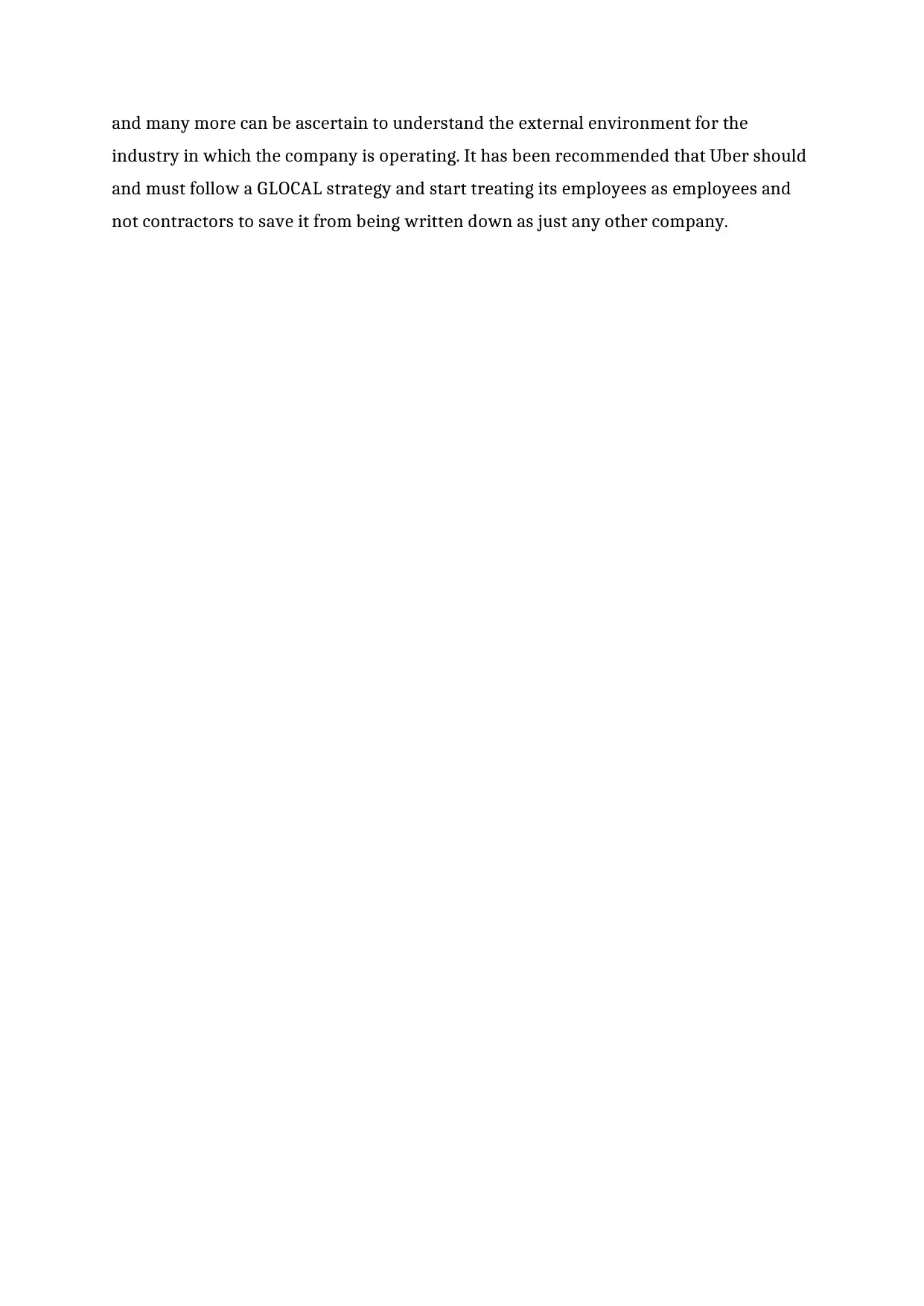
and many more can be ascertain to understand the external environment for the
industry in which the company is operating. It has been recommended that Uber should
and must follow a GLOCAL strategy and start treating its employees as employees and
not contractors to save it from being written down as just any other company.
industry in which the company is operating. It has been recommended that Uber should
and must follow a GLOCAL strategy and start treating its employees as employees and
not contractors to save it from being written down as just any other company.
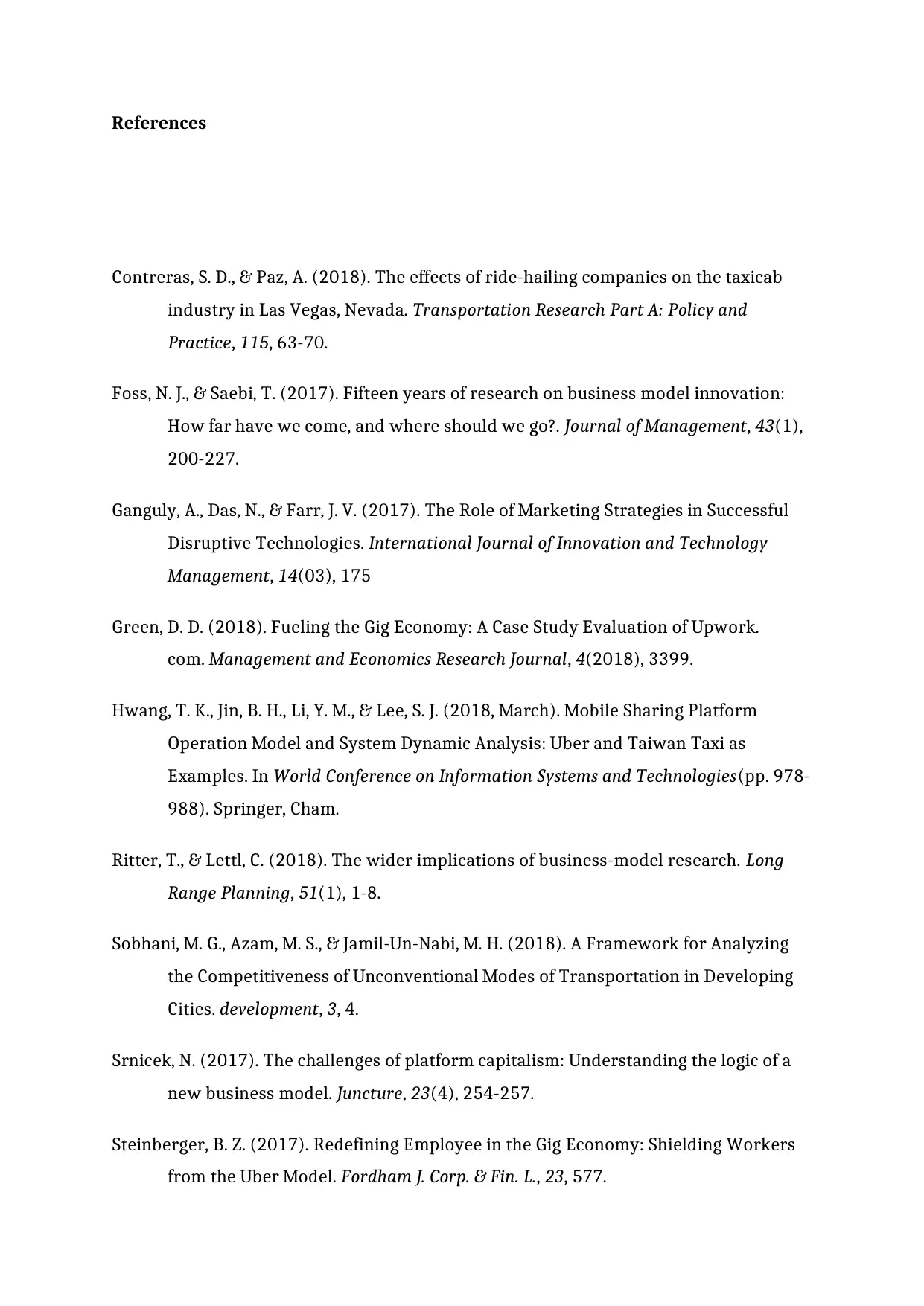
References
Contreras, S. D., & Paz, A. (2018). The effects of ride-hailing companies on the taxicab
industry in Las Vegas, Nevada. Transportation Research Part A: Policy and
Practice, 115, 63-70.
Foss, N. J., & Saebi, T. (2017). Fifteen years of research on business model innovation:
How far have we come, and where should we go?. Journal of Management, 43(1),
200-227.
Ganguly, A., Das, N., & Farr, J. V. (2017). The Role of Marketing Strategies in Successful
Disruptive Technologies. International Journal of Innovation and Technology
Management, 14(03), 175
Green, D. D. (2018). Fueling the Gig Economy: A Case Study Evaluation of Upwork.
com. Management and Economics Research Journal, 4(2018), 3399.
Hwang, T. K., Jin, B. H., Li, Y. M., & Lee, S. J. (2018, March). Mobile Sharing Platform
Operation Model and System Dynamic Analysis: Uber and Taiwan Taxi as
Examples. In World Conference on Information Systems and Technologies(pp. 978-
988). Springer, Cham.
Ritter, T., & Lettl, C. (2018). The wider implications of business-model research. Long
Range Planning, 51(1), 1-8.
Sobhani, M. G., Azam, M. S., & Jamil-Un-Nabi, M. H. (2018). A Framework for Analyzing
the Competitiveness of Unconventional Modes of Transportation in Developing
Cities. development, 3, 4.
Srnicek, N. (2017). The challenges of platform capitalism: Understanding the logic of a
new business model. Juncture, 23(4), 254-257.
Steinberger, B. Z. (2017). Redefining Employee in the Gig Economy: Shielding Workers
from the Uber Model. Fordham J. Corp. & Fin. L., 23, 577.
Contreras, S. D., & Paz, A. (2018). The effects of ride-hailing companies on the taxicab
industry in Las Vegas, Nevada. Transportation Research Part A: Policy and
Practice, 115, 63-70.
Foss, N. J., & Saebi, T. (2017). Fifteen years of research on business model innovation:
How far have we come, and where should we go?. Journal of Management, 43(1),
200-227.
Ganguly, A., Das, N., & Farr, J. V. (2017). The Role of Marketing Strategies in Successful
Disruptive Technologies. International Journal of Innovation and Technology
Management, 14(03), 175
Green, D. D. (2018). Fueling the Gig Economy: A Case Study Evaluation of Upwork.
com. Management and Economics Research Journal, 4(2018), 3399.
Hwang, T. K., Jin, B. H., Li, Y. M., & Lee, S. J. (2018, March). Mobile Sharing Platform
Operation Model and System Dynamic Analysis: Uber and Taiwan Taxi as
Examples. In World Conference on Information Systems and Technologies(pp. 978-
988). Springer, Cham.
Ritter, T., & Lettl, C. (2018). The wider implications of business-model research. Long
Range Planning, 51(1), 1-8.
Sobhani, M. G., Azam, M. S., & Jamil-Un-Nabi, M. H. (2018). A Framework for Analyzing
the Competitiveness of Unconventional Modes of Transportation in Developing
Cities. development, 3, 4.
Srnicek, N. (2017). The challenges of platform capitalism: Understanding the logic of a
new business model. Juncture, 23(4), 254-257.
Steinberger, B. Z. (2017). Redefining Employee in the Gig Economy: Shielding Workers
from the Uber Model. Fordham J. Corp. & Fin. L., 23, 577.
⊘ This is a preview!⊘
Do you want full access?
Subscribe today to unlock all pages.

Trusted by 1+ million students worldwide
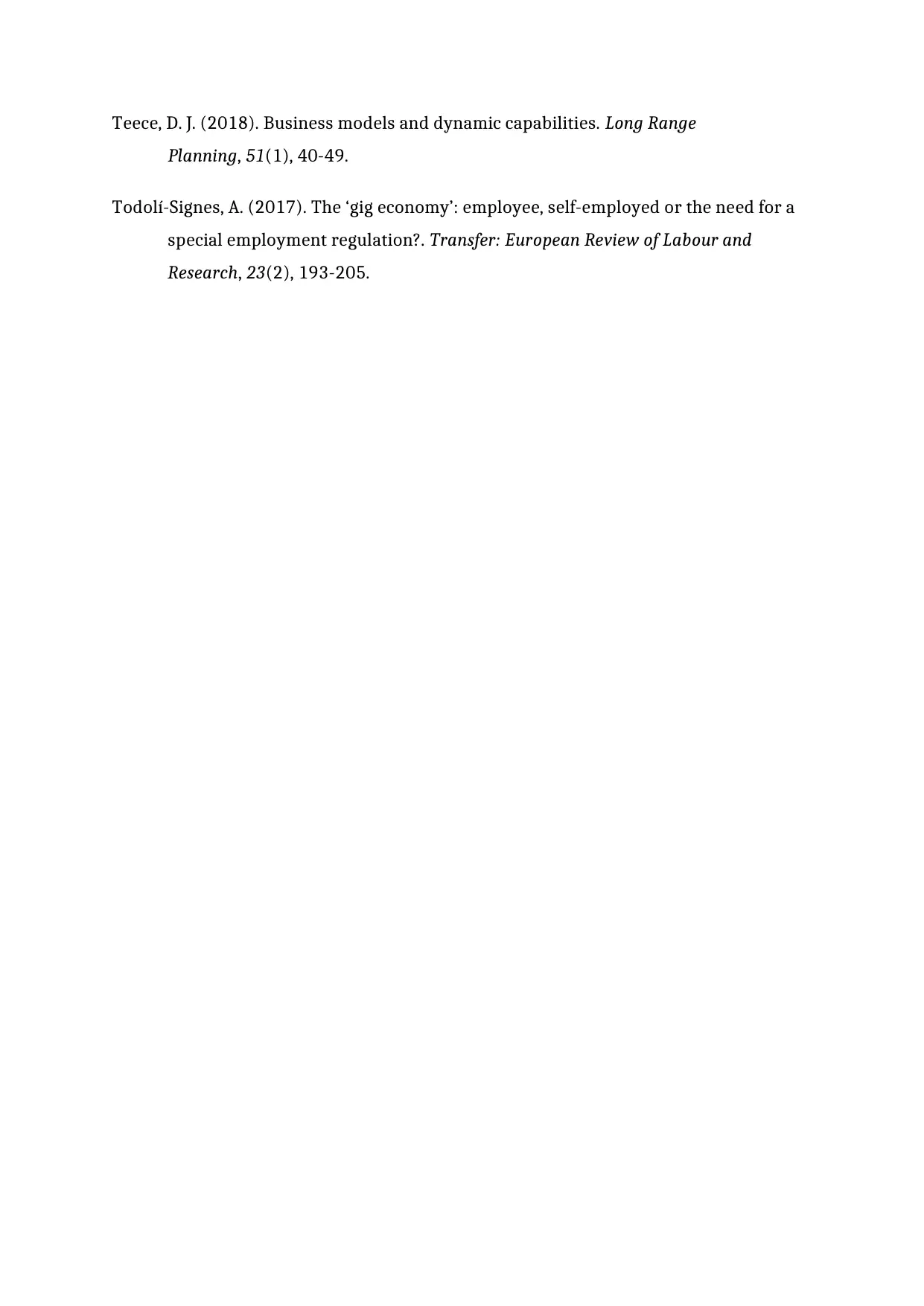
Teece, D. J. (2018). Business models and dynamic capabilities. Long Range
Planning, 51(1), 40-49.
Todolí-Signes, A. (2017). The ‘gig economy’: employee, self-employed or the need for a
special employment regulation?. Transfer: European Review of Labour and
Research, 23(2), 193-205.
Planning, 51(1), 40-49.
Todolí-Signes, A. (2017). The ‘gig economy’: employee, self-employed or the need for a
special employment regulation?. Transfer: European Review of Labour and
Research, 23(2), 193-205.
1 out of 10
Related Documents
Your All-in-One AI-Powered Toolkit for Academic Success.
+13062052269
info@desklib.com
Available 24*7 on WhatsApp / Email
![[object Object]](/_next/static/media/star-bottom.7253800d.svg)
Unlock your academic potential
Copyright © 2020–2025 A2Z Services. All Rights Reserved. Developed and managed by ZUCOL.





